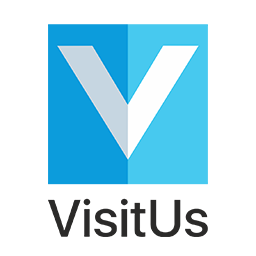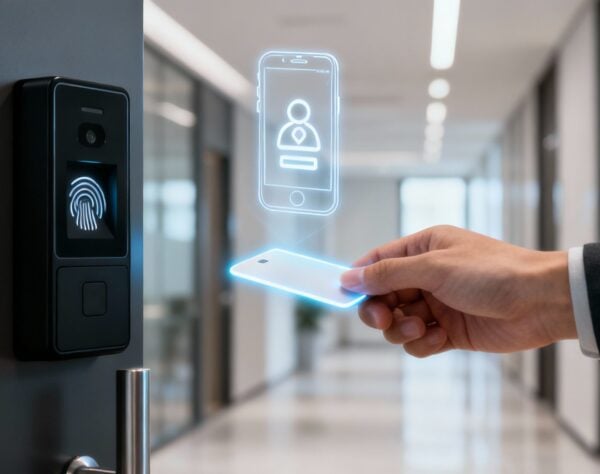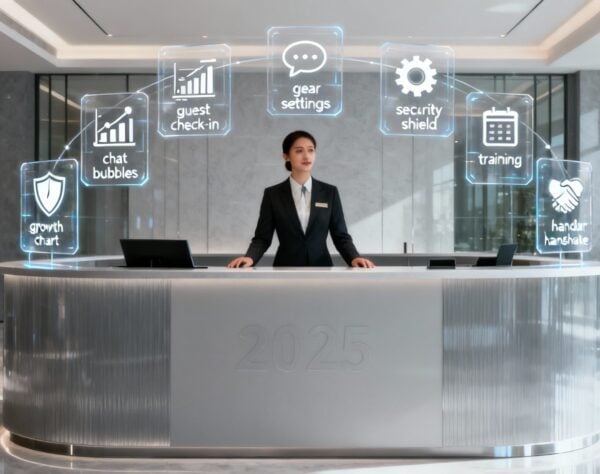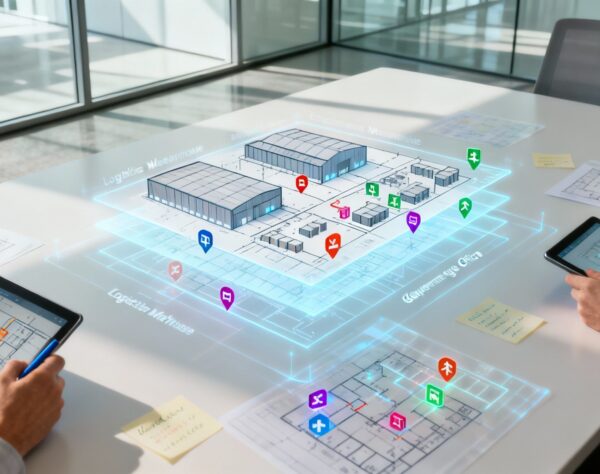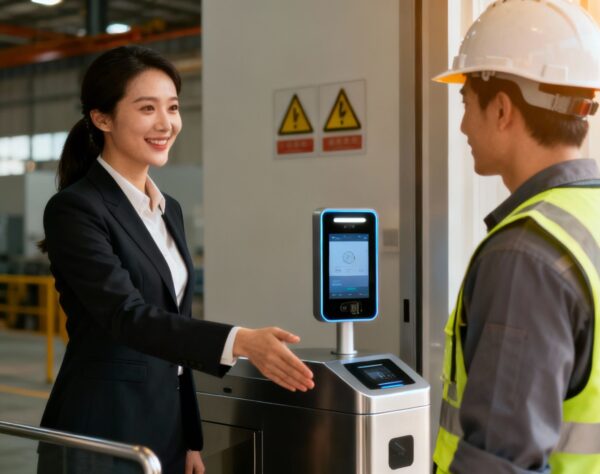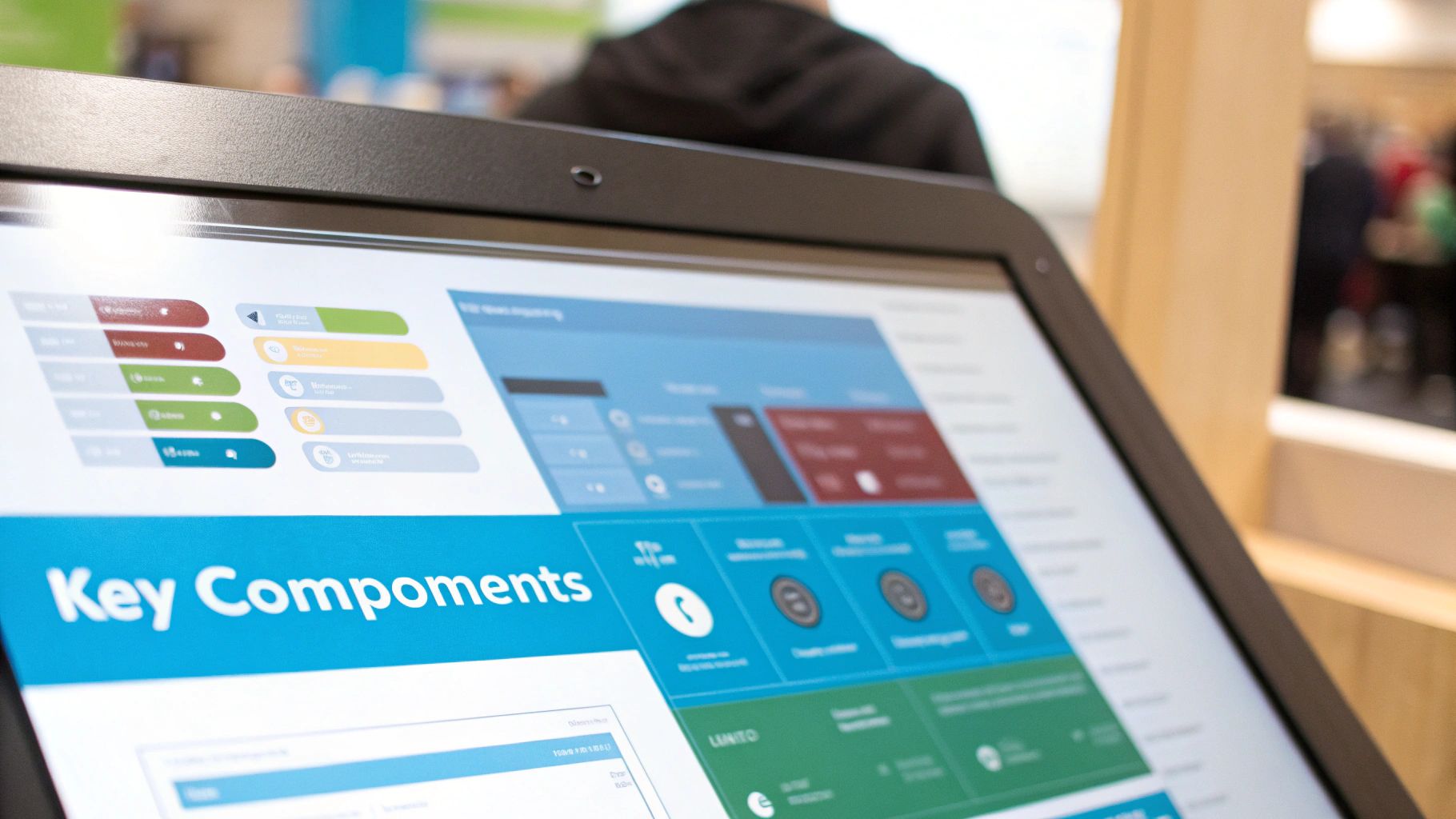
What Is a Visitor Management System?
Let's be honest, the old paper logbook on the reception desk is a dusty relic, not a security tool. A visitor management system (VMS) isn't just a digital upgrade; it's a strategic tool for enhancing security, boosting efficiency, and perfecting the all-important first impression.
Think of it as your building's intelligent welcome committee and security checkpoint rolled into one. It automates the entire process of welcoming, managing, and tracking every person who enters your facility—from guests and contractors to interview candidates.
What Is a Visitor Management System Really?
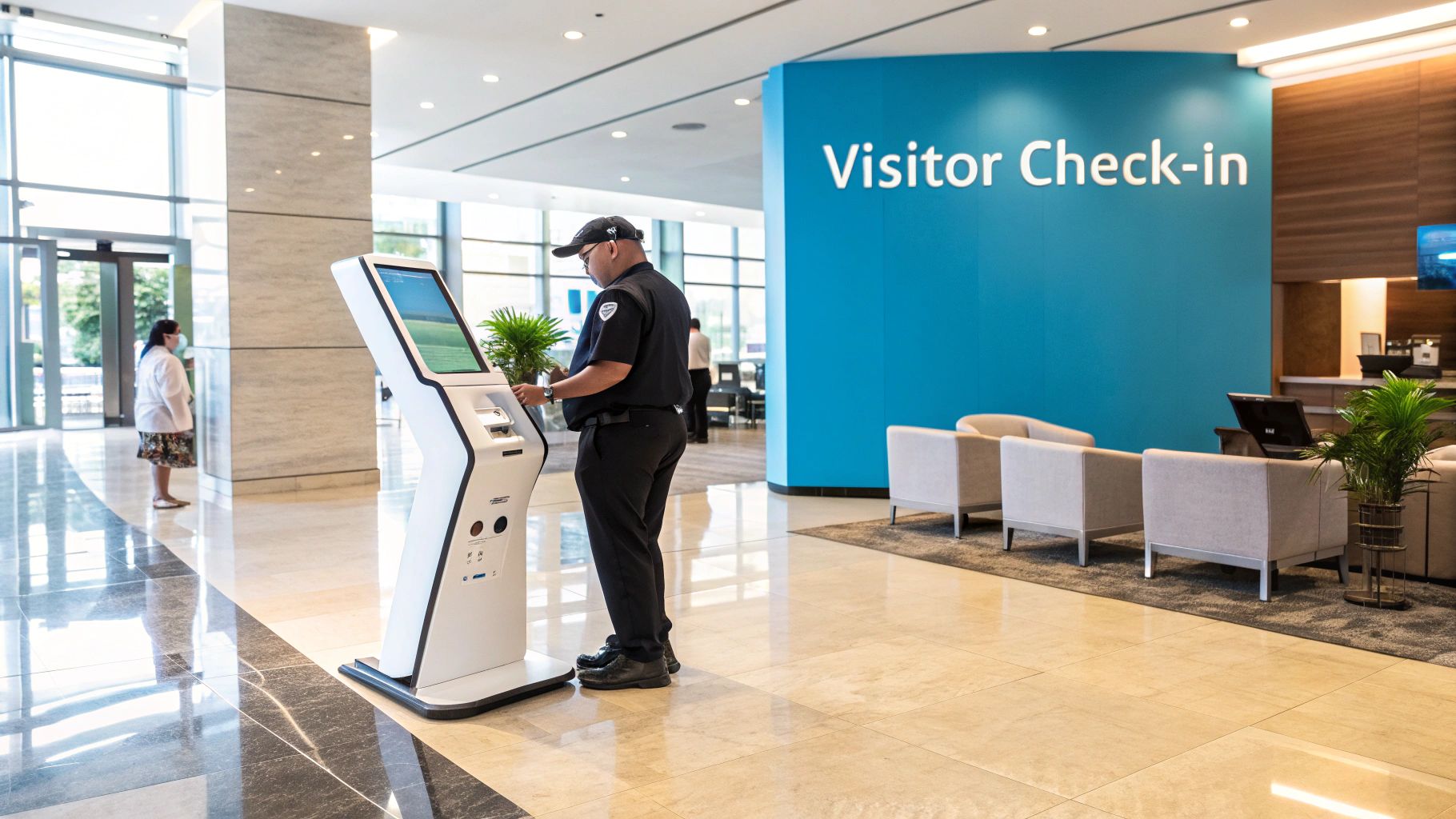
Let’s cut through the jargon. A traditional paper sign-in sheet is like a hand-drawn map—messy, insecure, and offering a vague idea of who came and went. In contrast, a modern VMS is like a sophisticated GPS for your building.
Its true benefit is the ability to provide real-time data on who is on-site, create the most efficient check-in experience, and send instant alerts about security red flags. The value isn't just digitizing a logbook; it's actively protecting your people, property, and data from the moment a guest arrives, a benefit that 85% of organizations cite as a key reason for adoption.
From Manual Logbooks to Modern Visitor Management
Switching from paper to a modern system delivers a massive leap in security and professionalism. The real-world differences are stark.
| Aspect | Traditional Paper Logbook | Modern Visitor Management System |
|---|---|---|
| First Impression | Clunky, slow, and outdated. | Sleek, professional, and welcoming. |
| Security | Zero identity verification. Visitor data exposed for all to see. | Verifies identity, pre-screens against watchlists, and keeps data private. |
| Efficiency | Manual, slow check-ins with messy, unreadable handwriting. | Fast, automated check-in in seconds. Instant host notifications. |
| Compliance | No reliable way to ensure NDAs are signed. Difficult to audit. | Automates NDA/document signing and creates a clean, searchable digital audit trail. |
| Emergency Prep | Useless. Who can you account for in an emergency? | Provides an accurate, real-time list of everyone on-site for evacuations. |
The takeaway is clear: paper logs are not just inefficient; they are a significant security and compliance risk that a modern system is designed to eliminate.
The Growing Importance of Visitor Management
A robust visitor management process is no longer a "nice-to-have" but a fundamental part of modern security and operational excellence. This isn't just a trend; it's becoming a standard for any forward-thinking organization.
Market data confirms this shift. The global visitor management system market is projected to skyrocket, reaching $7.26 billion by 2034—a massive jump from its current value of approximately $1.66 billion. This explosive growth underscores how essential these systems have become. You can dive deeper into this topic in our ultimate guide to visitor management systems.
A visitor management system offers robust tools that simplify the process of tracking and managing visitors, who often present the greatest risk to an organization. It enhances efficiency and effectiveness, fostering a safer and more secure environment.
So, when we ask what a visitor management system is, the answer extends far beyond a check-in app. It's an integrated solution that fortifies your security, streamlines your front desk, and ensures you're always prepared for an audit or an emergency.
The Core Benefits Driving VMS Adoption
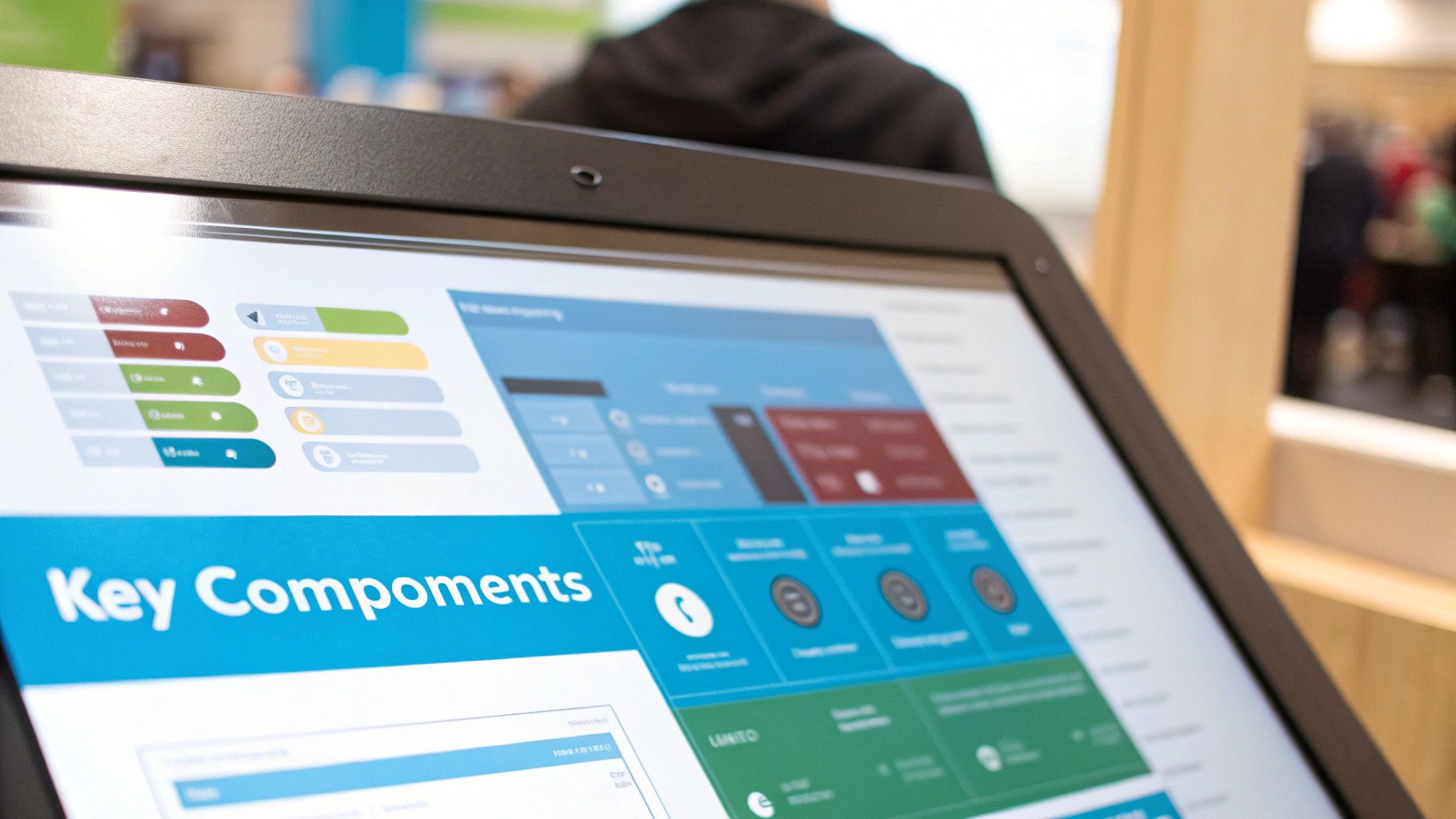
Why are so many companies ditching paper logbooks? This is a strategic move driven by measurable benefits. The reasons boil down to three massive advantages: rock-solid security, smoother operations, and hassle-free compliance. A VMS transforms the front desk from a potential weak spot into a powerhouse of efficiency and control.
Bolster Your First Line of Defense
Effective security means knowing exactly who is in your building at all times. This is where a VMS becomes your most important line of defense. While a paper log lets anyone scribble any name, a VMS actively verifies visitor identity, a crucial step since visitors can present a significant security risk.
Systems can even screen guests against internal or external watchlists in real time. This automated check is impossible to perform manually and allows you to prevent entry to individuals who might pose a threat. The result? 80% of organizations using a VMS report a significant improvement in physical security.
A Visitor Management System offers robust tools that simplify the process of tracking and managing visitors. This enhanced oversight allows for quick responses to any suspicious activity, ensuring that potential threats are addressed promptly.
This proactive approach frees up your security team to focus on critical tasks, rather than getting bogged down in administrative work.
Streamline Operations and Boost Efficiency
Every minute your reception team spends on manual tasks is a minute wasted. A VMS automates these jobs, benefiting both staff and guests. With pre-registration, a guest can fill out details and sign an NDA before arrival. When they get to your office, a quick QR code scan is all it takes to print their badge and notify their host. This simple workflow can slash check-in times by over 80%.
The benefits of this automation are clear:
- Instant Notifications: Hosts are instantly pinged via email, SMS, or platforms like Microsoft Teams the moment their guest arrives.
- Reduced Lobby Congestion: Faster check-ins eliminate long lines and create a more professional first impression.
- Time Savings: Front-desk staff are freed from data entry and phone tag, allowing them to focus on higher-value responsibilities.
These efficiencies align with the broader Business Process Automation Benefits, leading to enhanced productivity and real cost savings.
Achieve Effortless Compliance and Auditing
Staying compliant with regulations like GDPR, HIPAA, or ITAR is a major challenge. A VMS transforms this complex chore into a simple, automated process. It becomes your digital filing cabinet, creating a perfect, auditable trail that proves due diligence.
Instead of chasing paper signatures for NDAs, the VMS makes signing these documents a mandatory step in the check-in flow, ensuring 100% compliance before a badge is printed. For rules like GDPR, a VMS is a lifesaver. You can set it to automatically purge visitor data after a set period, demonstrating responsible data handling. During an audit, having a clean, searchable digital record is priceless. You can see a more detailed breakdown in our guide to the top 5 benefits of a visitor management system.
How a Modern VMS Works Step by Step
Let's pull back the curtain on how a modern VMS transforms the clunky sign-in process into a smooth, connected experience. Following a visitor from invitation to departure is the best way to see the benefits in action.
The entire process is built for efficiency and security, ensuring guests feel welcome while your team maintains a complete, real-time view of who is on-site. This is about completely rethinking the visitor lifecycle.
The Visitor Journey: A Story in Four Steps
To truly understand what a visitor management system does, let’s walk through a common scenario. Imagine a consultant, Jane, is coming to meet your project manager, David.
-
Pre-Registration and Invitation: The experience begins long before Jane arrives. When David schedules the meeting, the VMS can automatically send her a welcome email containing meeting details, directions, and a unique QR code for touchless check-in. Jane can pre-fill her details and sign an NDA from her phone, saving time for everyone. This step often integrates with tools for automated meeting scheduling, keeping calendars and visitor logs perfectly synced.
-
Seamless On-Site Arrival: When Jane arrives, she bypasses the reception line. Instead of a clipboard, she scans her QR code at a lobby kiosk. In seconds, the system confirms her identity and appointment.
-
Automatic Host Notification: The moment Jane scans her code, the system notifies David via his preferred channel—email, SMS, or a direct message in Slack or Microsoft Teams. It simply says, "Your guest, Jane, has arrived." No need for the receptionist to track him down.
-
Badge Printing and Access: Simultaneously, a professional, branded visitor badge is printed with Jane’s name, photo, host, and an expiry time. This simple but effective security measure allows your team to identify authorized guests at a glance.
This entire sequence demonstrates how much friction a VMS removes from the visitor experience.
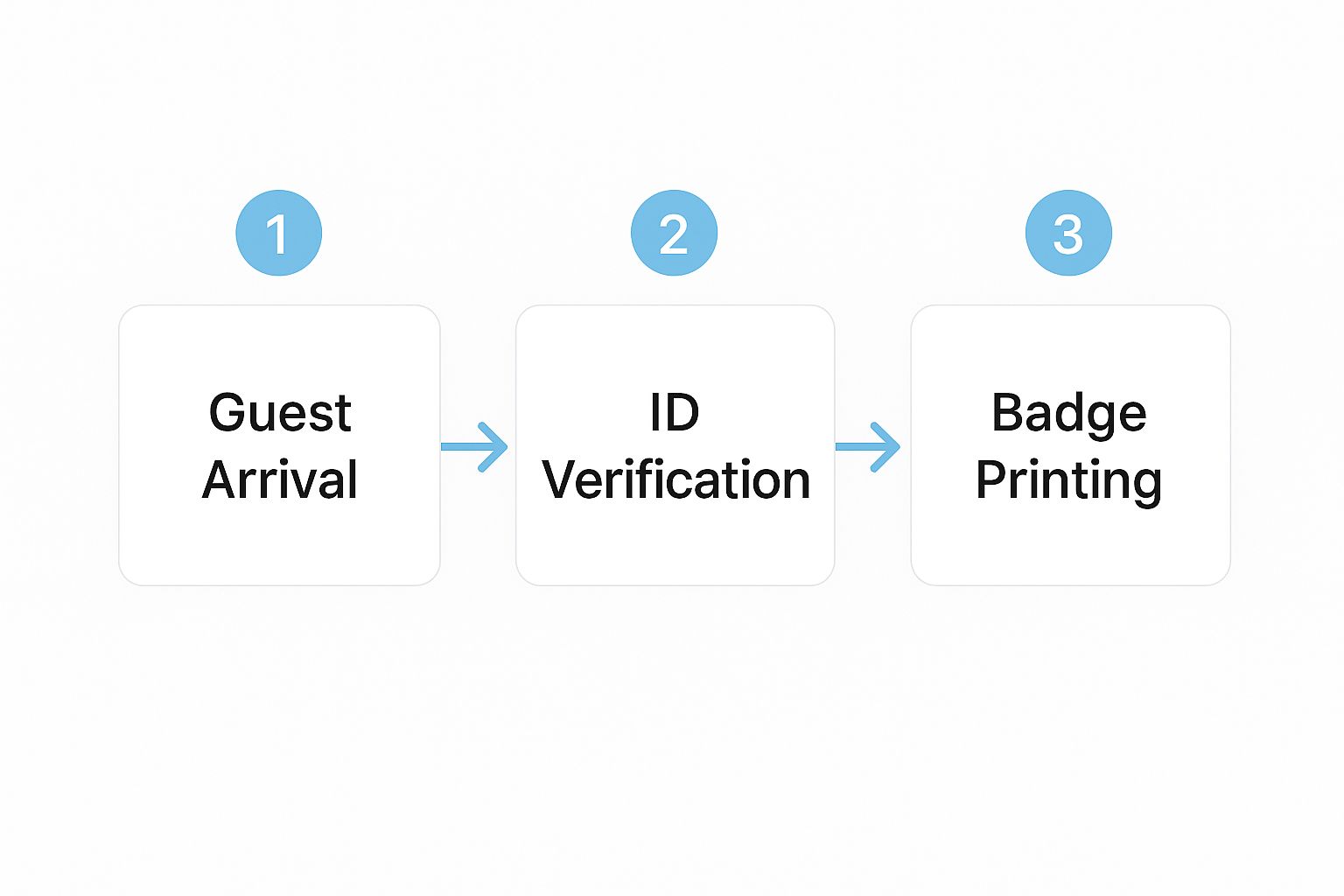
This infographic visually represents the core check-in steps. The key benefit is how every step is automated and connected, eliminating manual work and closing potential security gaps.
The Power Behind the Scenes: The Backend Dashboard
While your visitor enjoys a smooth front-end experience, your admin and security teams have a powerful command center running in the background. This is where the real management happens.
From this central dashboard, your team can monitor all site activity in real time, set up different sign-in rules for various visitor types (e.g., contractors vs. interviewees), and pull detailed security reports on demand.
The real power of a VMS is its ability to provide a complete, 360-degree view of your facility's traffic. It's not just about who checked in; it's about having an accurate, live record of everyone on-site, which is critical for both daily security and emergency situations.
This backend is also where hardware and software converge, integrating devices like tablets, badge printers, and QR code scanners into one unified system. The demand for such technology is booming, with the VMS market projected to hit USD 4.8 billion by 2034, up from USD 1.7 billion today. This growth is driven by the need for advanced hardware often produced in tech hubs like Taiwan and South Korea.
Understanding these steps is the first move toward implementation. If you’re considering that leap, our guide on how to set up a visitor management system is the perfect next step.
How Different Industries Benefit from a VMS
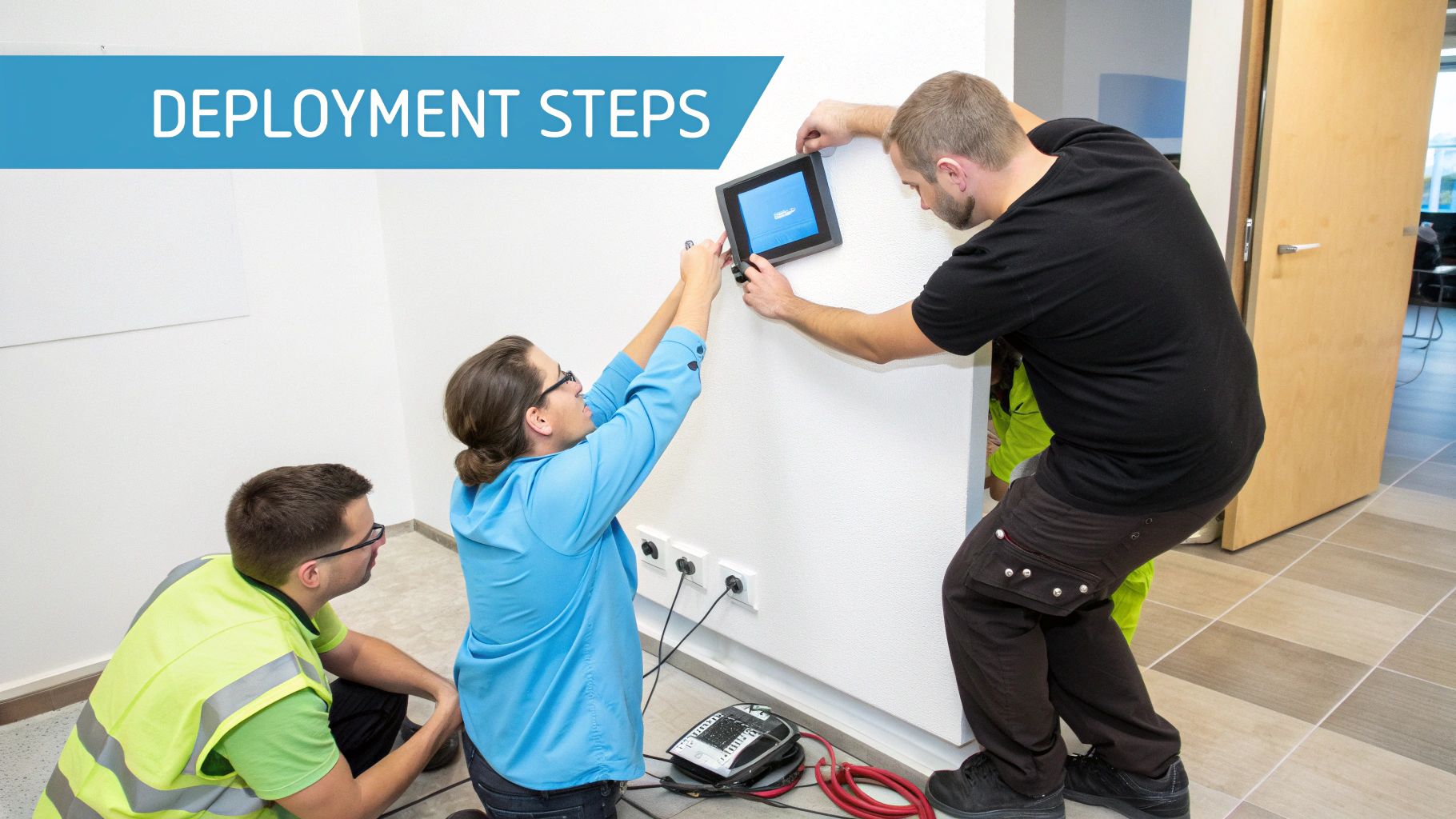
A visitor management system (VMS) isn't a one-size-fits-all solution; its strength lies in its adaptability. From schools to manufacturing plants, every industry faces unique challenges. A modern VMS is designed to tackle these specific problems head-on.
The benefit is less about the technology and more about how it solves real-world issues—whether that’s protecting students or securing proprietary data. The best way to understand what a visitor management system is is to see its tailored benefits across various sectors.
Corporate Offices Creating a Modern Brand Image
In the corporate world, first impressions are critical. A paper sign-in book can make an otherwise modern company feel outdated. A sleek VMS, however, immediately projects a professional image.
This improved visitor experience is a top priority for 72% of companies aiming to boost customer satisfaction. But it’s not just about appearances. Corporate offices are hubs of intellectual property. A VMS protects sensitive information by requiring visitors to digitally sign non-disclosure agreements (NDAs) during check-in, ensuring 100% compliance before they pass reception.
Manufacturing and Industrial Sites Enforcing Safety
On a manufacturing floor, safety is the top priority. The constant flow of contractors and suppliers creates significant risk if not managed properly. A VMS becomes an essential safety tool in this environment.
Instead of just hoping a contractor has the right certifications, a VMS can require them to watch a safety video and pass a quiz before their badge is printed. This automated step drastically reduces the risk of on-site accidents. In fact, companies using a VMS report a 40% reduction in workplace incidents involving third parties.
Think of a VMS in these high-risk environments as a digital safety officer. It makes sure every single person on-site has acknowledged and understood the safety rules, creating a clear, auditable record that protects both the workers and the company.
For high-security sectors like defence and essential services, a VMS is non-negotiable for maintaining tight security and ensuring only pre-approved personnel access critical areas.
Healthcare Facilities Protecting Patient Privacy
In healthcare, patient privacy is mandated by law. Hospitals must adhere to strict HIPAA regulations, and managing the endless stream of visitors and vendors is a massive compliance challenge. A VMS provides the control needed to meet these standards.
The system can screen visitors against pre-approved lists, ensuring only authorized individuals access patient floors. It also creates a private, digital log—a huge upgrade from exposed paper sign-in sheets that are a recipe for a privacy breach. This is why over 90% of healthcare facilities are expected to use digital check-in systems by 2026.
Here’s how a VMS benefits healthcare:
- HIPAA Compliance: It keeps visitor data secure and confidential, unlike an open logbook.
- Infection Control: The system can ask visitors health screening questions, helping to stop the spread of illnesses.
- Vendor Management: It logs all vendor visits and ensures they adhere to facility policies, creating a perfect audit trail.
For more details, explore why healthcare facilities are switching to digital check-in systems.
Schools and Campuses Safeguarding Students
Nothing is more important in a school than student safety. A VMS is a game-changer for screening every person who walks in, from parents to contractors.
The system can instantly check a visitor's ID against national sex offender registries and internal watchlists, triggering an immediate alert if a threat is detected. This automatic screening provides a level of security that is impossible to achieve manually. During an emergency, a VMS delivers a real-time, accurate list of every visitor on campus to first responders—a feature that can be a genuine life-saver.
Still Have Questions About Visitor Management?
Choosing a VMS is an important decision, and it’s natural to have questions. You need to be sure it's the right move for your security, budget, and daily operations. Let's tackle the most common questions with direct, practical answers.
Are These Systems Hard to Set Up and Use?
Not at all. A key benefit of modern cloud-based systems is their user-friendliness. Setup is surprisingly simple, with intuitive web dashboards for customizing branding and sign-in questions.
Hardware like iPads and badge printers is designed to be plug-and-play. The visitor experience is self-guided, walking them through check-in in seconds. Most providers also offer robust customer support to ensure a smooth transition.
What Does a Visitor Management System Actually Cost?
The cost depends on your needs, primarily the number of locations, expected visitor volume, and required features like access control integrations.
Most modern providers use a subscription model (SaaS), billed monthly or annually per location. A basic plan covers essentials like sign-in, notifications, and badging, while higher tiers unlock advanced security and automation tools. When considering the price, weigh it against the significant return on investment in enhanced security, efficiency, and guaranteed compliance.
Think of it this way: investing in a VMS isn't just another operational expense. It's a direct investment in mitigating risk. The cost of a single security breach or compliance fine can easily dwarf the annual subscription for a system designed to prevent those very problems.
Can a VMS Work With Our Other Office Tools?
Yes, and this is where a VMS truly shines. A modern system is built to integrate with the tools you already use, creating seamless, automated workflows. These connections eliminate tedious data entry and strengthen your entire operation.
- Communication Tools: Integrations with Slack and Microsoft Teams send instant host notifications, so guests are never left waiting.
- Calendar Systems: Linking to Outlook or Google Calendar enables automatic pre-registration when a meeting is booked.
- Access Control Systems: Connecting to systems from providers like Lenel or Brivo is a game-changer. The VMS can grant temporary, restricted access to visitors, which is automatically revoked upon sign-out.
How Do These Systems Handle Data Privacy and Security?
Data security is the top priority for any reputable VMS provider. Platforms are built on a foundation of trust and designed to protect both your data and your visitors' personal information.
They use strong encryption for all data, whether in transit or at rest. Most are hosted on secure cloud infrastructure like Amazon Web Services (AWS) or Microsoft Azure, which offer world-class security. A VMS is also a key tool for your own compliance with data privacy laws like GDPR, allowing you to set automated data retention policies to securely delete visitor information after a set period.
Ready to see how a modern VMS can transform your front desk into a powerhouse of security and efficiency? VisitUs offers a secure, intuitive, and fully customizable visitor management system that adapts to your unique needs. Discover the VisitUs difference today and take the first step toward a safer, more professional workplace.
Article created using Outrank
